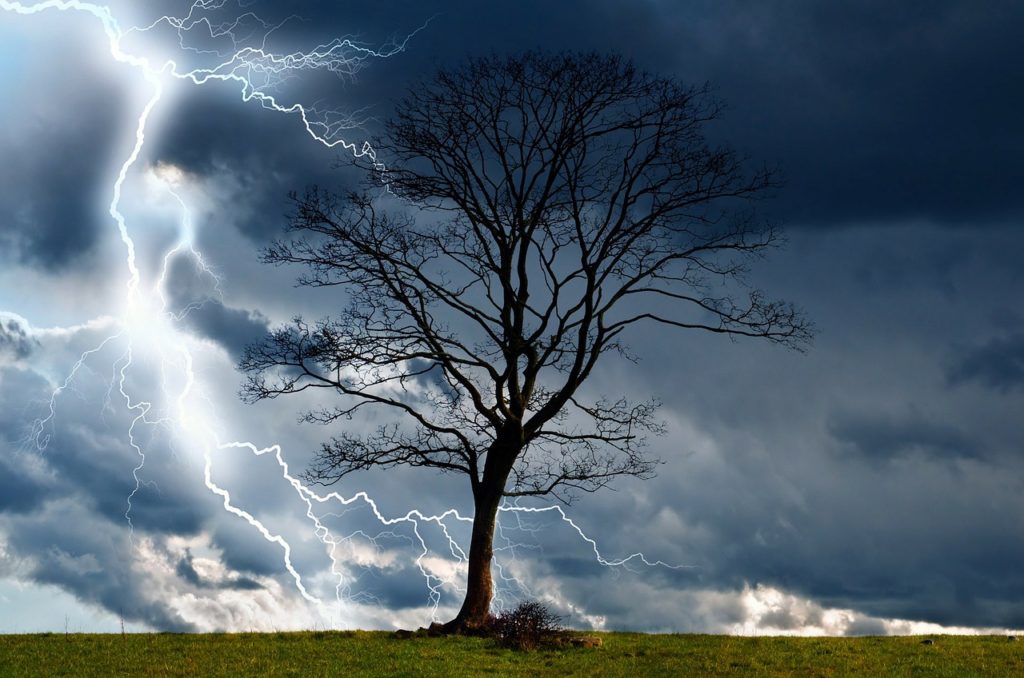Lightning is one of the most powerful forces on earth. It is hotter than the surface of the sun, producing temperatures of 53,540 degrees Fahrenheit. A single bolt of lightning can extend more than five miles in length, and contain up to one billion volts of electrical energy. Its capacity for destruction is great, and when it strikes, it can obliterate trees and cause extensive damage to both landscapes, and nearby buildings. For trees that survive, lightning strikes can cause structural degradation, a result of the heat generated by the electrical charge. Certain tree species, such as poplars, oaks, pines, and maples are more easily damaged than others.
Lightning protection systems can minimize the risk of damage from a lightning strike. They are installed in trees that are susceptible to lightning, and act as conductors, capturing the electrical current, and directing it safely into the earth. Trees that stand alone in an open landscape or grow at a higher elevation are more prone to lightning strikes, and can benefit from the installation of a lightning protection system. Lightning protection systems can also help to secure trees that are of historic or financial value, and are advisable for any trees that are rooted within ten feet of a structure or building.
Installing a Lightning Protection System
A lightning protection system is comprised of a series of copper conductors that extend from the top of a tree, down to its main branches and trunk, and finally, out beyond the tree where they are installed underground.
The uppermost point of the system is called the air terminal, which is attached to the tree using barbed copper nails. Larger trees require one central air terminal, and three to five secondary terminals. In trees that have a broader crown, the air terminals are located near the top of any major leaders or branches present in the tree.
The main conductor is a copper cable that connects to the primary air terminal, and then proceeds to run down the tree’s main branches and trunk. The cable is attached to the tree at three foot intervals using a series of conductor attachments. The secondary conductor cables connect to the secondary terminals at three foot intervals, and are then tied into the main conductor. Conductors should not be overly taut; the tree’s branches should be able to sway with ease.
Once the conductors have been established, each cable should be properly grounded. The cables extend out from the tree, and are buried to a depth of eight to twelve inches below the soil surface. Each cable is then attached to a copper-clad, or copper-weld ground rod that measures approximately eight to ten feet in length, and half an inch in diameter. In softer soil, the ground rod is driven into the earth at a depth of ten feet. For dry, rocky, or sandy soils, each cable should be forked to several ground rods for additional stability. If the soil is too dense, attempt to cut below ground level, and then drive each ground rod at least six feet below the soil surface. Grounding resistance will vary depending on the type of soil, and soil moisture, but it should not exceed fifty ohms (an ohm is a unit of electrical resistance). Ground rods should never be installed near underground utilities or storage tanks, and grounding conductors should not dangle, or pass over utilities or tanks. Once each cable has been properly grounded, the system is fully established, and will help to protect the tree from lightning strikes.
When trees grow together in a cluster, larger trees with protection systems installed can offer support to any smaller trees growing around them. If two or more trees are rooted closely together, and they each have their own protection system installed, their grounding cables should be connected.
In order to assure proper safety, and efficacy, lightning protection systems should always be approved by the National Fire Protection Association (NFPA), or the Lightning Protection Institute (LPI). Inspect each system annually to ensure their functionability. When a tree has grown past the system’s air terminals, the conductors and cables should be extended to accommodate the tree’s growth. If the tree overtakes the conductors, the system will still remain functional.
